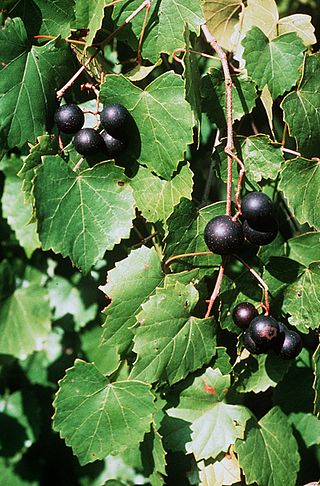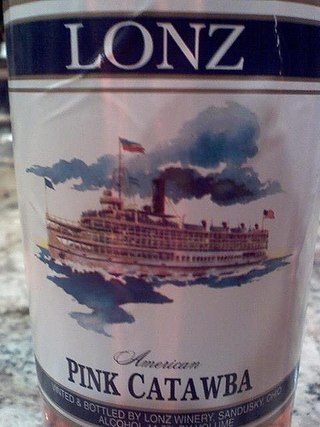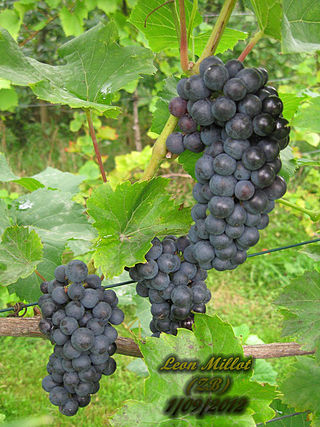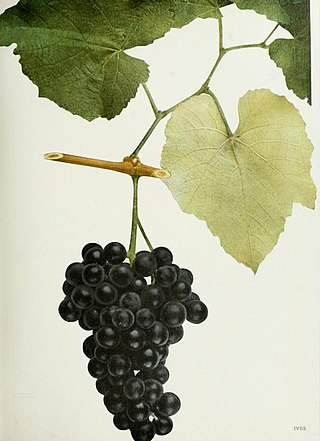
A grape is a fruit, botanically a berry, of the deciduous woody vines of the flowering plant genus Vitis. Grapes are a non-climacteric type of fruit, generally occurring in clusters.

Chambourcin is a variety of grapevine belonging to the Vitis genus in the flowering plant family Vitaceae. It is a French-American interspecific hybrid grape variety used for making wine. Its parentage is uncertain, but genetics studies shows it likely includes several North American Vitis species in its background including: V. berlandieri Planch., V. labrusca L., V. lincecumii Buckley, V. riparia Michx., V. rupestris Scheele, and V. vinifera. The hybrid was produced by Joannes Seyve who often used Seibel hybrids produced in the 1860s. The grape has only been available since 1963; it has a good resistance to fungal disease, and is one of the parents of the new disease resistant variety, Regent, which is increasing in popularity among German grape growers.

Vitis vinifera, the common grape vine, is a species of flowering plant, native to the Mediterranean region, Central Europe, and southwestern Asia, from Morocco and Portugal north to southern Germany and east to northern Iran. There are currently between 5,000 and 10,000 varieties of Vitis vinifera grapes though only a few are of commercial significance for wine and table grape production.

Vitis rotundifolia, or muscadine, is a grapevine species native to the southeastern and south-central United States. The growth range extends from Florida to New Jersey coast, and west to eastern Texas and Oklahoma. It has been extensively cultivated since the 16th century. The plants are well-adapted to their native warm and humid climate; they need fewer chilling hours than better known varieties, and thrive in summer heat.

Norton is grown in the Midwestern United States, the Mid-Atlantic States, and northeastern Georgia. DNA data are consistent with 'Norton' being a hybrid with ancestry including V. aestivalis and V. vinifera.

Catawba is a red American grape variety used for wine as well as juice, jams and jellies. The grape can have a pronounced musky or "foxy" flavor. Grown predominantly on the East Coast of the United States, this purplish-red grape is a likely cross of the native American Vitis labrusca and the Vitis vinifera cultivar Semillon. Its exact origins are unclear but it seems to have originated somewhere on the East coast from the Carolinas to Maryland.

Vitis labrusca, the fox grape, is a species of grapevines belonging to the Vitis genus in the flowering plant family Vitaceae. The vines are native to eastern North America and are the source of many grape cultivars, including Catawba, Concord, Delaware, Isabella, Niagara, and many hybrid grape varieties such as Agawam, Alexander and Onaka. Among the characteristics of this vine species in contrast to the European wine grape Vitis vinifera are its "slip-skin" that allows the skin of the grape berries to easily slip off when squeezed, instead of crushing the pulp, and the presence of tendrils on every node of the cane. Another contrast with European vinifera is the characteristic "foxy" musk of V. labrusca, best known to most people through the Concord grape. This musk is not related to the mammalian fox, but rather to the strong, earthy aromas characteristic of the grapes that were known by early European-American settlers in the New World. The term "foxy" became a sort of catchall for the wine tasting descriptors used for these American wines that were distinct from the familiar flavors of the European viniferous wines.

Grape juice is obtained from crushing and blending grapes into a liquid. In the wine industry, grape juice that contains 7–23 percent of pulp, skins, stems and seeds is often referred to as must. The sugars in grape juice allow it to be used as a sweetener, and fermented and made into wine, brandy, or vinegar.
Vitis × labruscana is a subgroup of grapes originating from a hybridization of Vitis labrusca and Vitis vinifera. Popular examples include Concord and Niagara grapes, which comprise nearly all grapes processed for juice or jelly in the United States. Such cultivars are frequently referred to as "labrusca", however many are as little as half Vitis labrusca in their pedigree. Another common term, arguably more accurate, is "labrusca-type". These varieties do in fact possess many of the traits of Vitis labrusca, frequently including slipskin fruit, strong "foxy" flavor/odor, and large leaves with lighter colored and pubescent undersides. Most are self-fertile, unlike wild Vitis labrusca.

Hybrid grapes are grape varieties that are the product of a crossing of two or more Vitis species. This is in contrast to crossings between grape varieties of the same species, typically Vitis vinifera, the European grapevine. Hybrid grapes are also referred to as inter-species crossings or "Modern Varieties." Due to their often excellent tolerance to powdery mildew, other fungal diseases, nematodes, and phylloxera, hybrid varieties have, to some extent, become a renewed focus for European breeding programs. The recently developed varieties are examples of newer hybrid grape varieties for European viticulturalists. Several North American breeding programs, such as those at Cornell and the University of Minnesota, focus exclusively on hybrid grapes, with active and successful programs, having created hundreds if not thousands of new varieties.

Kyoho grapes are a fox grape (Concord-like) cross popular in East Asia. The fruits are blackish-purple, or almost black, with large seeds and juicy flesh with high sugar content and mild acidity. The variety was first produced by the Japanese viniculturist Yasushi Ohinoue in the 1930s and 1940s by crossing Ishiharawase and Centennial grape varieties. Kyoho is a tetraploid grape variety, as its breeding parents, ‘Ishiharawase’ and ‘Centennial’ are tetraploid bud sports of ‘Campbell Early’ and ‘Rosaki’, respectively. Like the Concord, Kyoho is a slip-skin variety, meaning that the skin is easily separated from the fruit. The seeds are bitter and the skin is not traditionally eaten. The grape maintains some of the flavor qualities of the Concord, known to consumers from the flavor of most grape jellies and Concord grape juice.

The Delaware grape is a cultivar derived from the grape species Vitis labrusca or 'Fox grape' which is used for the table and wine production.

The Isabella grape is a cultivar derived from the grape species Vitis labrusca or 'fox grape,' which is used for table, juice and wine production.

Vitis (grapevine) is a genus of 79 accepted species of vining plants in the flowering plant family Vitaceae. The genus is made up of species predominantly from the Northern Hemisphere. It is economically important as the source of grapes, both for direct consumption of the fruit and for fermentation to produce wine. The study and cultivation of grapevines is called viticulture.
This glossary of viticultural terms list some of terms and definitions involved in growing grapes for use in winemaking.
Black Spanish is a variation of grape that was originally assumed to be a seedling of an American hybrid grape which resulted from the crossing of the American Vitis aestivalis species with that of an unknown Vitis vinifera. The vinifera is suspected to have been the pollen donor.

Léon Millot is a red variety of hybrid grape used for wine. It was created in 1911 in the Oberlin Institute in Colmar, Alsace, by the French viticulturist Eugène Kuhlmann (1858–1932) by crossing the hybrid grape Millardet et de Grasset 101-14 O.P. with Goldriesling, which is Vitis vinifera. The variety was named after the winemaker and tree nursery owner Léon Millot.

Thomcord is a seedless table grape variety and a hybrid of the popular Thompson Seedless or Sultanina grape and Concord grape. Thomcord was developed in 1983 by Californian grape breeders working for the Agricultural Research Service (ARS), an agency of the United States Department of Agriculture (USDA), as part of a test to better understand a new seedless grape breeding procedure.

Ives noir is a red hybrid grape variety that is grown throughout the United States. Named after its propagator, Connecticut wine grower Henry Ives, the grape's pedigree and exact origin are unclear. After Prohibition in the United States, Ives was a popular grape used in the production of sweet port-style wines but saw its plantings steadily decrease throughout the 20th century as the vine's susceptibility to air pollution took its toll.




















